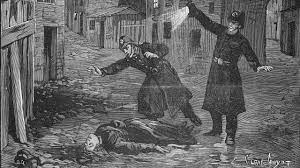In the late 19th century, a series of gruesome murders sent shockwaves through the streets of Victorian-era London. The perpetrator, known as Jack the Ripper, terrorized the impoverished district of Whitechapel, targeting vulnerable prostitutes. Despite intensive investigations and public outcry, the true identity of the notorious killer remains a mystery to this day. This article delves into the number of known victims, the methods of murder employed, and the factors that contributed to Jack the Ripper’s ability to evade capture.

Number of known victims
Mary Ann Nichols:
Mary Ann Nichols, also known as “Polly,” was the first victim of Jack the Ripper, murdered on August 31, 1888. She was a 42-year-old prostitute struggling with alcoholism and poverty. Her body was found in Buck’s Row (now Durward Street) in Whitechapel.
The post-mortem examination revealed that her throat had been deeply slashed, almost to the point of decapitation. Additionally, her abdomen was brutally mutilated, with several deep and jagged incisions. The savagery of the mutilations indicated a level of surgical skill, leading some to speculate that the killer might have had medical knowledge.
Annie Chapman:
Annie Chapman, aged 47, became the second victim on September 8, 1888. Like Mary Ann Nichols, she was also a prostitute facing destitution. Her body was discovered in the backyard of 29 Hanbury Street, Spitalfields.
Annie’s throat had been slit, and her body bore even more extensive mutilations than the previous victim. Her abdomen was cut open, and some of her organs were removed and placed on her shoulder. The nature of the mutilations led to heightened fear and outrage among the public, earning the killer the infamous moniker “Jack the Ripper.”
Elizabeth Stride:
Elizabeth Stride, a 44-year-old prostitute, met her tragic fate on September 30, 1888. Her body was found on Berner Street (now Henriques Street) in Dutfield’s Yard.
Unlike the previous victims, Elizabeth’s murder appeared less mutilated, leading some to speculate that the killer might have been interrupted during the act. Her throat was slashed, but her abdomen was left untouched. Some researchers even question whether Elizabeth Stride’s murder was genuinely the work of Jack the Ripper or if it was the act of a different killer.
Catherine Eddowes:
On the same night as Elizabeth Stride’s murder, September 30, 1888, Catherine Eddowes also fell victim to the hands of Jack the Ripper. Catherine was a 46-year-old prostitute, and her body was found in Mitre Square, Aldgate.
Catherine’s murder exhibited a level of brutality similar to the earlier victims. Her throat was slashed, and her abdomen was eviscerated, with her intestines thrown over her shoulder. Additionally, her face was mutilated, with her nose and cheek gashed. The extent of the mutilations horrified the public and increased the pressure on the authorities to apprehend the killer.
Mary Jane Kelly:
Mary Jane Kelly, aged 25, was the final confirmed victim of Jack the Ripper, murdered on November 9, 1888. She was a young prostitute who lived in Miller’s Court, off Dorset Street, Spitalfields.
Mary Jane Kelly’s murder was the most gruesome of all. Her body was found in her small rented room, and the extent of mutilation was beyond comprehension. Her face was hacked beyond recognition, her throat was severed down to the spine, and her abdomen was almost emptied of organs. The scene was so horrific that it deeply traumatized those who discovered it. You can read more about it in great detail here.
The killer’s elusiveness
Numerous factors contributed to Jack the Ripper’s ability to elude capture:
Limited forensic technology: During the 1880s, forensic investigation techniques were still in their infancy. The lack of advanced tools and methods made it challenging for the police to collect substantial evidence at the crime scenes.
Poor living conditions and distrust of authorities: The Whitechapel district was known for its extreme poverty and social unrest. The locals were wary of the police and often unwilling to cooperate with the authorities due to their difficult living conditions, hindering the investigation.
Lack of eye witnesses: The killings typically occurred in dimly lit, secluded areas during the late hours, where few witnesses were present. The lack of reliable eye witnesses made it challenging for investigators to piece together the events leading to the murders.
Taunting letters: Jack the Ripper further taunted the police and public by sending letters to the media, signed “Jack the Ripper.” These letters added to the fear and confusion surrounding the case but provided little actionable information to identify the killer.
Missteps in the investigation: Several investigative errors, including the accidental destruction of potential evidence and unreliable witness testimonies, hindered progress in solving the case.
Conclusion
The case of Jack the Ripper remains one of history’s most notorious unsolved mysteries. The shadowy killer’s identity continues to elude researchers, spawning numerous theories and speculations over the years. The Whitechapel murders serve as a grim reminder of the challenges faced in historical criminal investigations and continue to captivate the public’s imagination with the enigmatic figure of Jack the Ripper lurking in the dark corners of history.



